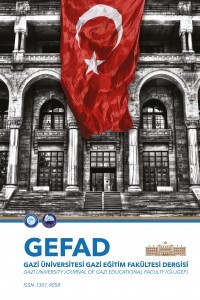Fizik Eğitiminde 5E Modelinin Öğrencilerin Akademik Başarısına Etkisinin İncelenmesi
Bu çalışmada; GATA Sağlık Astsubay Hazırlama Okulu 1. sınıfta yer alan Fizik dersinde, 5E Modeli esas alınarak, İki Boyutta Atış Hareketi (Yatay ve Eğik Atış Hareketi) konusunda uygulanan dersin; öğrencilerin öğrenmesindeki etkililiği araştırılmış ve sonuçlar ortaya konularak önerilerde bulunulmuştur. Konu seçimi yapılırken, uygulama yapılan öğrencilerin askeri öğrenci olması nedeniyle hem onların ilgisini çekecek, hem de anlamakta zorlandıkları “İki Boyutta Atış Hareketi (Yatay ve Eğik Atış Hareketi)” konuları seçilmiştir. Araştırma 2004- 2005 bahar yarıyılında GATA Sağlık Astsubay Hazırlama Okulu 1. sınıfta öğrenim gören 84 öğrenci ile yürütülmüştür. Araştırmada her konu için ayrı ayrı çoktan seçmeli başarı testleri kullanılmıştır. Uygulama sonucu yapılan analizlerde In this research; during the Physics Education course in GATA Medical Noncommissioned Officer Preparatory School\'s first grade, Projectile Motion in Two Dimension has been applied to the students with the fundamental principles of 5E Model and the effectiveness of the Physics Education course for the students has been searched. Morever, after presenting the outcomes, some suggestions have been presented. While chosing the course subject, since, the students to whom the course subject has been applied are cadets, Projectile Motion in Two Dimension subjects are chosen since they are both complex and interesting. The researh has been carried out with 84 students who were in GATA Medical Noncommissioned Officer Preparatory School\'s First Grade. In the researh, multiple choice success tests have been applied for each subject. In the analysis made after the application, It has been obser5E Modeli, Fizik Eğitimi, İki Boyutta Atış Hareketi.5E Model, Physics Education, Projectile Motion in Two Dimensions. Tam Metin
Anahtar Kelimeler:
5E Modeli, Fizik Eğitimi, İki Boyutta Atış Hareketi.
To Examine the Effects of 5E Model on the Students Academic Success in Physics Education
In this research; during the Physics Education course in GATA Medical Noncommissioned Officer Preparatory School\'s first grade, Projectile Motion in Two Dimension has been applied to the students with the fundamental principles of 5E Model and the effectiveness of the Physics Education course for the students has been searched. Morever, after presenting the outcomes, some suggestions have been presented. While chosing the course subject, since, the students to whom the course subject has been applied are cadets, Projectile Motion in Two Dimension subjects are chosen since they are both complex and interesting. The researh has been carried out with 84 students who were in GATA Medical Noncommissioned Officer Preparatory School\'s First Grade. In the researh, multiple choice success tests have been applied for each subject. In the analysis made after the application, It has been obser5E Modeli, Fizik Eğitimi, İki Boyutta Atış Hareketi.5E Model, Physics Education, Projectile Motion in Two Dimensions. Tam Metin
___
- Başaran, İ., Ethem. (1978). Eğitime Giriş. Ankara: Bimaş Matbaacılık.
- Ergin, İ. (2006) Fizik Eğitiminde 5E Modelinin Öğrencilerin Akademik Başarısına, Tutumuna Ve Hatırlama Düzeyine Etkisine Bir Örnek: “İki Boyutta Atış Hareketi”-Yayınlanmamış Doktora Tezi, Gazi Üniversitesi Eğitim Bilimleri Enstitüsü, Ankara.
- Ünal, Hatice. (2003). “Öğrenme Halkası Yöntemi’nin Fen Bilgisi Dersi “Maddelerin Sınıflandırılması ve Dönüşümleri” Konusunun Öğretilmesinde Başarıya Etkisi”. Yayınlanmamış Yüksek Lisans Tezi. İstanbul: Marmara Üniversitesi Eğitim Bilimleri Enstitüsü.
- İşman, A., Ç. Baytekin, F. Balkan, M. B. Horzum, M. Kıyıcı. (2002). Fen Bilgisi Eğitimi ve Yapısalcı Yaklaşım. The Turkish Online Journal of Educational Technology–(TOJET), 1 (1), 7.
- Özmen, Haluk. (2004). Fen Öğretiminde Öğrenme Teorileri ve Teknoloji Destekli Yapılandırmacı (Constructivist) Öğrenme. The Turkish Online Journal of Educational Technology–(TOJET), 3 (1), 14.
- Ünsal, Y., B. Güneş. (2002). Bir Kitap İnceleme Çalışması Örneği Olarak MEB İlköğretim 4. Sınıf Fen Bilgisi Ders Kitabına Fizik Konuları Yönünden Eleştirel Bir Bakış. Gazi Üniversitesi Gazi Eğitim Fakültesi Dergisi, 22 (3), 107-120.
- Kanlı, U. (2007). 7E Modeli Merkezli Laboratuvar İle Doğrulama Laboratuvar Yaklaşımlarının Öğrencilerin Bilimsel Süreç Becerilerinin Gelişimine ve Kavramsal Başarılarına Etkisinin Karşılaştırılması- Yayınlanmamış Doktora Tezi, Gazi Üniversitesi Eğitim Bilimleri Enstitüsü, Ankara.
- Keser, Ö. F. (2003). Fizik Eğitimine Yönelik Bütünleştirici Bir Öğretim Ortamı Tasarımı ve Uygulaması. Yayınlanmamış Doktora Tezi. Karadeniz Teknik Üniversitesi Fen Bilimleri Enstitüsü, Trabzon.
- Martin, D. J. (2000). Elementary Science Methods: A Constructivist Approach. Belmont, CA: Wadsworth/Thomason Learning.
- Carin, A., J. Bass. (2005). Teaching Science As Inquiry. Upper Saddle River, New Jersey: Pearson Prentice Hall.
- Newby, Diane E. (2004). Using Inquiry to Connect Young Learners to Science, Natioal Charter Schools Institute. (http://www. nationalcharterschools.org/ uploads /pdf/resource_20040617125804_Using%20Inquiry.pdf). (20.04. 2003).
- Walker, Charles ve T. Angeleo. (1998). A Colctive Effort Classroom Assessment Technique: Promoting High Performance in Student Teams. New Directions For Teaching and Learning, 75, 101-112.
- ISSN: 1301-9058
- Yayın Aralığı: Yılda 3 Sayı
- Başlangıç: 1985
- Yayıncı: Gazi Üniversitesi
Sayıdaki Diğer Makaleler
Doğru Denklemi Konusunda Geliştirilen Bilgisayar
Fizik Eğitiminde 5E Modelinin Öğrencilerin Akademik Başarısına Etkisinin İncelenmesi
İsmet ERGİN, Uygar KANLI, Mustafa TAN
Carl Czerny nin Opus 299\19 Numaralı Etüdünün Piyano Eğitimine Yönelik Analizi
Aladağlar da Bitki Formasyonları ve Dağılışları
Ülkü Eser ÜNALDI, Emin TOROĞLU
Bilimsel Dergilerin İş Süreçleri Yönetimini Gerçekleştiren
Selçuk ÖZDEMİR, Bilal ATASOY, Sibel SOMYÜREK
Übersetzungskritische Untersuchung des Romans An diesem Dienstag Wolfgang Borcherts
Sakarya Nehri Çeltikçe Çayında Yaşayan Leuciscus cephalus L., 1758 Dokularında Ağır Metal Birikimi
